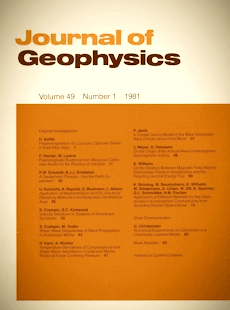Spherical-Earth gravity and magnetic anomaly modeling by Gauss-Legendre quadrature integration
Article Sidebar

Vols. 1-18 (1924-1944), ISSN 0044-2801
Main Article Content
Abstract
The usefulness of long-wavelength potential field anomalies in lithospheric interpretation is greatly increased with spherical Earth modeling techniques. Gauss-Legendre quadrature integration is used to calculate the anomalous potential of gravity and magnetic fields and their spatial derivatives on a spherical Earth for an arbitrary body represented by an equivalent point source distribution of gravity poles or magnetic dipoles. The distribution of equivalent point sources is determined directly from the coordinate limits of the source volume. Variable integration limits for an arbitrarily shaped body are derived from interpolation of points which approximate the body's surface envelope. The versatility of the method is enhanced by the ability to treat physical property variations within the source volume and to consider variable magnetic fields over the source and observation surface. A number of examples verify and illustrate the capabilities of the technique, including preliminary modeling of potential field signatures for Mississippi embayment crustal structure at satellite elevations.
 ARK: https://n2t.net/ark:/88439/y030173
ARK: https://n2t.net/ark:/88439/y030173
Permalink: https://geophysicsjournal.com/article/163
Article Details
References
Bhattacharyya, B.K. (1978) Computer modeling in gravity and magnetic interpretation. Geophysics 43:912-929
Cain, J.C., Hendricks, S.J., Langel, R.A., Hudson, W.V. (1967) A proposed model for the International Geomagnetic Reference Field, 1965. J. Geomagn. Geoelectr. 19:335-355
Carnahan, B., Luther, H.A., Wilkes, J.O. (1969) Applied Numerical Methods. J. Wiley and Sons, New York
Cordell, L. (1977) Regional positive gravity anomaly over the Mississippi Embayment. Geophys. Res. Lett. 4:285-287
Ervin, C.P., McGinnis, L.D. (1975) Reelfoot rift: Reactivated precursor to the Mississippi Embayment. Geol. Soc. Am. Bull. 86:1287-1295
Frese, R.R.B. von, Hinze, W.J., Braile, L.W., Luca, A.J. (1980) Spherical earth gravity and magnetic anomaly modeling by Gauss-Legendre quadrature integration. NASA Rept NAS5-25030
Hall, D.H. (1974) Long-wavelength aeromagnetic anomalies and deep crustal magnetization in Manitoba and Northwestern Ontario, Canada. Pageoph. 40:403-430
Heiskanen, W.A., Mortiz, H. (1967) Physical Geodesy. W.H. Freeman and Co., San Francisco
Ku, C.C. (1977) A direct computation of gravity and magnetic anomalies caused by 2- and 3-dimensional bodies of arbitrary shape and arbitrary magnetic polarization by equivalent point method and a simplified cubic spline. Geophysics 42:610-622
Langel, R.A. (1979) Near-earth satellite magnetic field measurements: A prelude to Magsat. EOS (Trans. Am. Geophys. Union) 60:667-668
McCamy, K., Meyer, R.P. (1966) Crustal results of fixed multiple shots in the Mississippi Embayment; In: Steinhart, J.S., Smith, T.J. (Eds.) The Earth Beneath the Continents, Am. Geophys. Union Geophys. Monogr. 19:370-381
Sass, J.H., Diment, W.H., Lachenbruch, A.H., Marshall, B.V., Munroe, R.J., Moses, T.H., Jr., Urban, T.C. (1976) A new heat-flow contour map of the conterminous United States. USGS, Open-file Rept. 76-756
Shuey, R.T., Schellinger, D.K., Johnson, E.H., Alley, L.B. (1973) Aeromagnetics and the transition between the Colorado Plateau and the Basin and Range Provinces. Geology 1:107-110
Stroud, A.H., Secrest, D. (1966) Gaussian Quadrature Formulas. Prentice-Hall, New Jersey
Talwani, M., Ewing, M. (1960) Rapid computation of gravitational attraction of three-dimensional bodies of arbitrary shape. Geophysics 25:203-225
Talwani, M. (1965) Computation with the help of a digital computer of magnetic anomalies caused by bodies of arbitrary shape. Geophysics 30:797-817
Warren, D.H., Healy, J.H. (1973) Structure of the crust in the conterminous United States. Tectonophysics 20:203-213
Wasilewski, P.J., Thomas, H.H., Mayhew, M.A. (1979) The Moho as a magnetic boundary, NASA Rept. NASA-GSFC TM80245
Woollard, G.P., Joesting, H.R. (1964) Bouguer gravity anomaly map of the United States. Am. Geophys. Union and U.S. Geological Survey, scale 1:2,500,000











